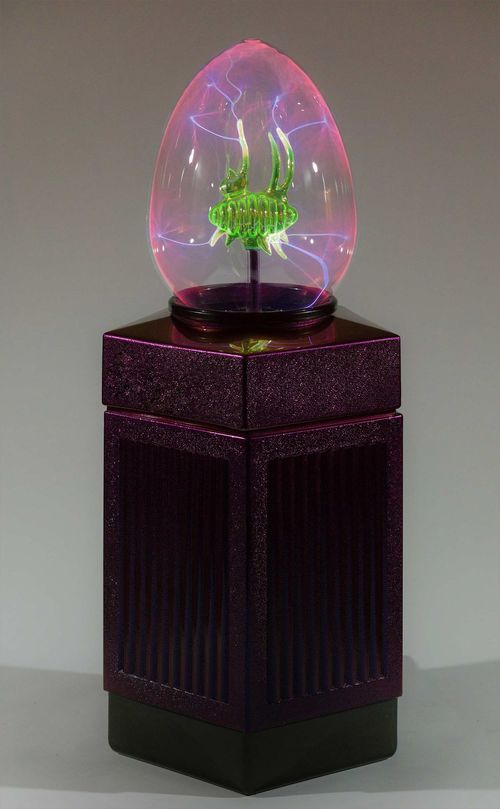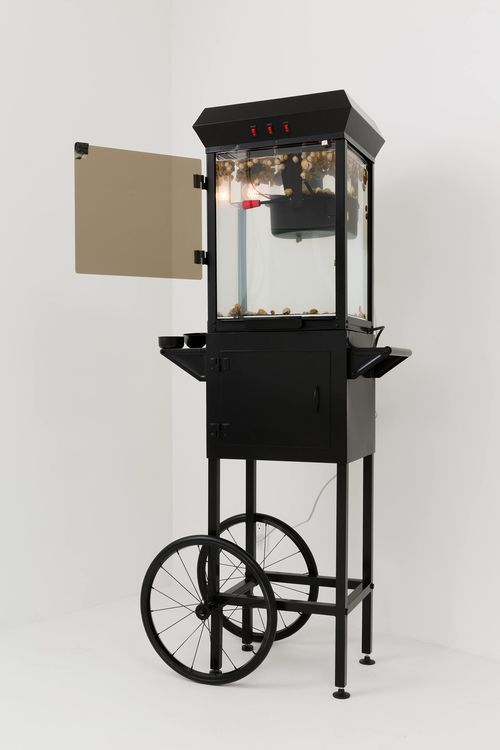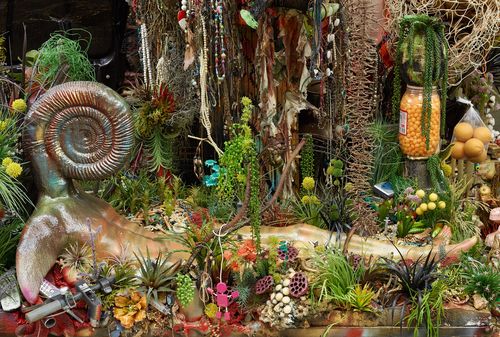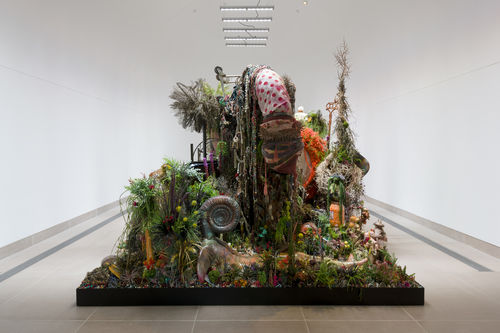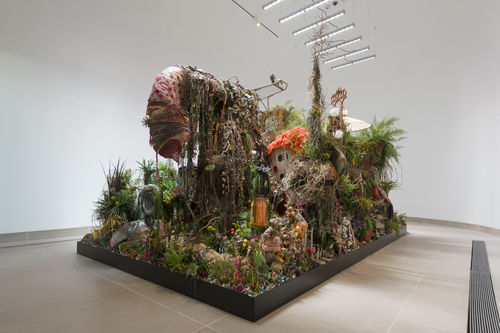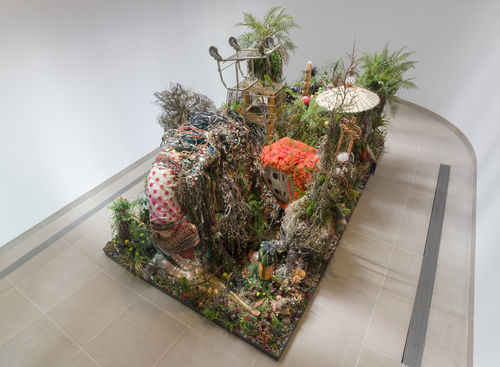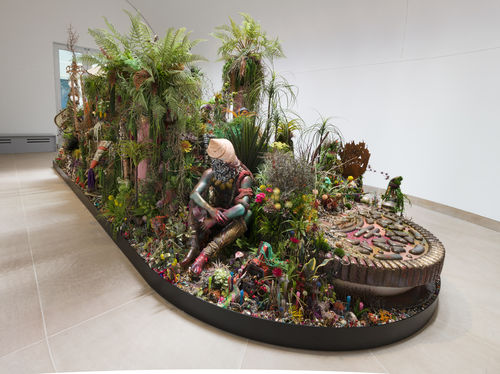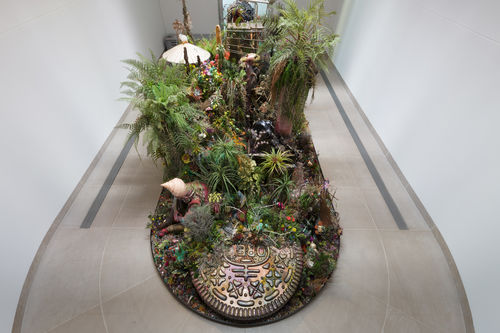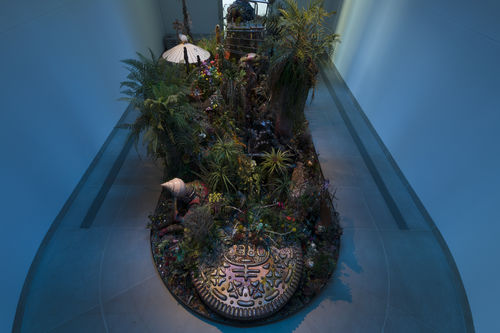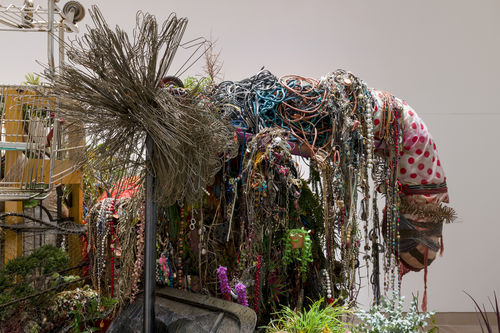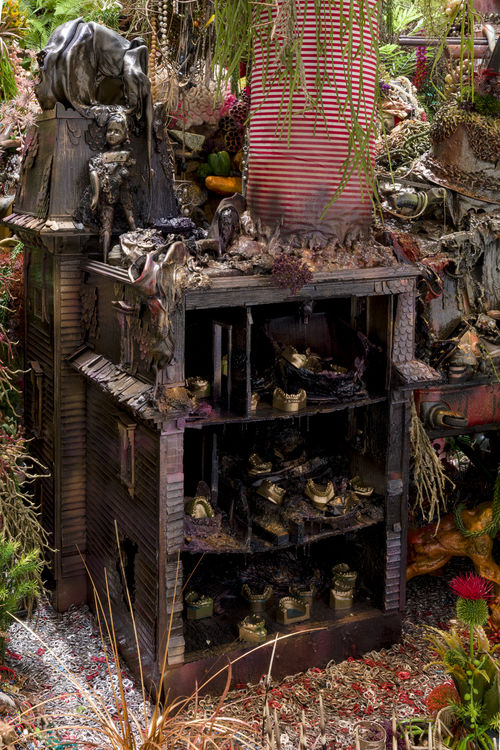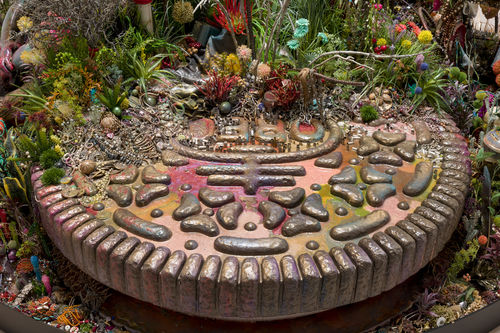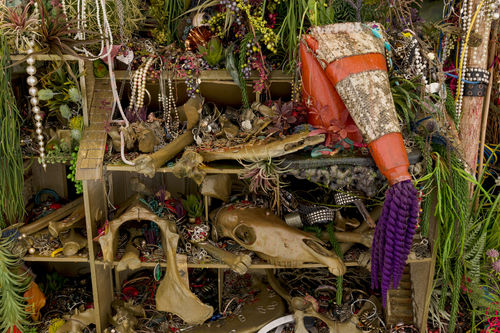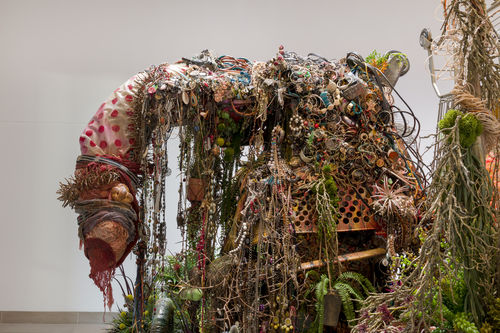
Hammer Projects: Max Hooper Schneider
- – This is a past exhibition
This immersive installation is Schneider’s first solo museum show.
Artists are often likened to inventors or scientists, and in the case of Max Hooper Schneider the comparison is more than metaphoric. Schneider’s background in landscape architecture and marine biology strongly informs his artwork. Research and scientific investigation are key to his process. He explores the relationships between philosophy and nature, the personal and the political, destruction and construction, and what he calls nonhuman and human agents. Blending his diverse areas of expertise, his idiosyncratic sculptures, installations, and drawings challenge conventional systems of classification, suggesting a worldview that strives to dislocate humans from their assumed position of centrality and superiority as knowers and actors in the world. Schneider will create a new immersive installation for his Hammer Projects exhibition, his first solo museum show.
Hammer Projects: Max Hooper Schneider is organized by Ali Subotnick, adjunct curator, with Vanessa Arizmendi, curatorial assistant.
Biography
Max Hooper Schneider (b. 1982, Los Angeles) has had solo exhibitions at Jenny’s, Los Angeles (2018 and 2014); High Art, Paris (2015); and Kayne Griffin Corcoran, Los Angeles (2015). His work has been featured in international group exhibitions such as the 16th Istanbul Biennial (2019); Creatures, Contemporary Arts Center, Cincinnati (2019); Give Up the Ghost, Baltic Triennial 13, Contemporary Art Centre, Vilnius (2018); Mutations, High Line, New York (2017–18); The Garden, ARoS Triennial, Aarhus, Denmark (2017); The New Normal, Ullens Center for Contemporary Art, Beijing (2017); Preservation, Marjorie Barrick Museum of Art, Las Vegas (2017); High Anxiety, Rubell Family Collection, Miami (2016); Retour sur Mulholland Drive, La Panacée, Montpellier, France (2016); Streams of Warm Impermanence, David Roberts Art Foundation, London (2016); Theories of Forgetting, Gagosian Gallery, Beverly Hills, CA (2015); and the Mongolia Land Art Biennial (2014 and 2012). Hooper Schneider received his master’s degree in landscape architecture from Harvard’s Graduate School of Design (2011) and his BA in design and architecture studies and biology from New York University (2005). In addition, he studied social science at the University of Chicago, entomology at the University of Hawaii, and marine biology at Santa Monica College. Hooper Schneider was selected for the fourth BMW Art Journey (2016) and will board the R/V Falkor, the Schmidt Ocean Institute’s oceanographic research vessel, in 2020. He lives and works in Los Angeles.
Essay
"While for the moment, the fates of human and non-human beings are inextricably entangled, the power of humans is waning. We arrived late on the planet and are likely to exit early." —Max Hooper Schneider
A mad scientist, magician, alchemist, trash master, doomsday predictor, and borderline hoarder, Max Hooper Schneider has spent the past decade developing a taxonomy of living things, dead technology, and refuse, transforming grotesque souvenirs of everyday life into exquisite objects and environments. His passions for the nonhuman world and marine biology fuel his explorations of the often tragic results of humanity’s interference with the natural world. The results are visceral scenarios reflecting on the nature of existence and environmental crises. Ostranenie—the artistic technique of presenting common things in an unfamiliar or strange way in order to enhance perception of the familiar—and techne—the ancient precept of material making—anchor Hooper Schneider’s approach to art making.
Hooper Schneider studied landscape architecture and marine biology in college, which provided access to facilities and labs where he could blow things up, cultivate glowing algae, and explore the habits and habitats of a plethora of specimens and exotic materials. Accordingly, research is central to his process, and his overflowing studio—Little Shop of Horrors meets a secondhand shop—functions like a laboratory where he can conduct off-label experiments and develop bootleg ecosystems. He is an incessant scavenger, trolling dumpsters, the beach, scrap-metal yards, anatomical replica companies, and the coffers of deceased relatives for discarded treasures. His vast collection of raw materials includes neon, bones (real and fake), scrap metal, sea creatures (also both real and fabricated), vintage toys, mannequins, junk jewelry, real and artificial plants, candy, fossils, death metal cassettes, discarded furniture, movie props, and more. He was, and still is, fascinated by tide pools and spent most of his free time observing these discrete worlds, which for the artist “represented something larger than myself . . . that exceeded my anthropocentric, postulatory thumbings at the ‘natural world.’ . . .
One could witness this multidimensional play of habitat creation and destruction, mutualistic partnerships, sieges of elemental forces, and peer into a phantasmagorical, subplanar vista of tube feet, stinging tentacles, and regenerated limbs.”1 One might not immediately associate Hooper Schneider with Marcel Duchamp, the godfather of postmodern art. His primary medium, however, is in fact found objects. He transforms and redigests existing materials (and occasionally organisms), or in his words, “my day job is to package gore.”2 For Aral Spring Trolley (2014), he turned a classic popcorn trolley into an aquarium for popcorn-shaped snails, and for Antemortem Sirenian (2018), the artist sliced open an animatronic manatee, exposing the fictive guts—sinewy wires and electrical cables. Hooper Schneider doesn’t just recontextualize found materials and objects; he treats them as ingredients in a recipe in which he creates something entirely new without concealing their original use or function. He humanizes (or more accurately animalizes) machines and human-made objects, exposing distinct biological characteristics. And as Barbara Hooper observes, “his worlds do not represent nature: They are nature… Of course, lobsters, fish, seahorses, spiny urchins. But boots, bullet casings, plastic chains? The works, if they are functioning as the artist would like them to, have opened at least this one small aporia, an aporia being, literally, something that stops you in your tracks.”3
While the subjects of Hooper Schneider’s works can be somewhat dismal, every doomsday diorama features elements of delight and wonder. His poignant and magical assemblages never fail to seduce and mesmerize. An early piece titled The Last Caucasian War (2014), for example, comprises his mother’s laptop submerged in muddy water, with tiny fiddler crabs crawling over it. This captivating scenario encapsulates the real and urgent crises of environmental degradation and climate change.
Hooper Schneider is probably best known for his Trans-Habitats, aquarium tanks teeming with an array of materials culled from his various collections in the studio or those sourced from the field, which he considers “worlds that materialize and dramatize in diverse ways nature conceived in a specifically monist mode—i.e., as a process of ceaseless morphogenic modulation, a relentless onslaught in which bodies, as formed matters, are continuously created, transformed, and destroyed. . . . My sculptures and systems deploy a set of conditions involving perceptual shift, interactivity, mutation, juxtaposition, containment, openness, life, death.”4 For example, each of the thirteen terraria in the Pet Semiosis series—such as Pet Semiosis 11: Leprosy (Hebrew) (2016), Pet Semiosis 5: Lethal Injection (Burmese) (2015), and Pet Semiosis 9: Coprolalia (Arabic) (2016)— displays a neon sign in a different language and alphabet, referencing a disease, symptom, or cause of death. More recently, he has produced the series Planetary Vitrines, larger-scale Trans-Habitats that grew out of his 2017 maritime expedition (supported by the BMW Art Journey initiative) to seven coral ecosystems in varying states of growth and decay—including White Island, New Zealand; Cocos Keeling, Indian Ocean; and Zighy Bay, Oman. Each reef biotope he visited suffered from a form of human interference followed by either efforts at damage control or total neglect. Hooper Schneider buried empty vitrines at two of the reef sites, leaving them to transform organically into “Trans-Habitats, co-created by artist, reef, and other natural and human participants in the process.”5
Continuing this narrative, Hooper Schneider’s Hammer Projects exhibition explores “climax communities,” which represent “the final stage of succession, remaining relatively unchanged until destroyed by a disaster or event caused by humans or other destructive forces, such as earthquakes, tsunamis, or large perturbations in the atmosphere,”6 inevitably leading to another precondition of succession. The artist argues that nature, in this exact way, exists in an ongoing state of climax and molecular flux. Circling back to his scavenging rituals, he has transmuted objects and materials that he has amassed over the years—burning, chopping, combining, and solidifying in a layer of marine epoxy and primordial ooze—into a landfill cascading into a reservoir of yet more stuff. It’s at once horrifying and intoxicating, seductive and foreboding. Baby dolls, plastic fruit, bullet shells, shopping carts, chains, air plants, a dollhouse, a suitcase, a pay phone, freeze-dried food, cables, car parts, wire hangers, plastic vines, a life-size plastic alligator, and more were combined into islands of debris, mini dumps within an archipelago, and baked in the New Mexico sun. Hybrid creatures—part human, part marine organism—reside within the cacophony, the sole survivors and inheritors of this new world. Like a walk-in diorama, the gallery becomes one of Hooper Schneider’s Trans-Habitats, where visitors experience a biosphere of a seemingly inevitable future. Every aspect of the installation is deliberate and considered, including the lighting, which replicates the sun’s transit, and the audio, an original soundtrack recorded with marine invertebrates and electric fish and produced in collaboration with the musician Jorge Elbrecht. With this immersive installation, Hooper Schneider provides a glimpse into his weird and wonderful mind, letting us see how he engages with the world and its inhabitants.
—Ali Subotnick
Notes
Epigraph: Max Hooper Schneider, “Loss and Gain,” in Max Hooper Schneider’s
Art Journey: Planetary Vitrine, ed. András Szántó (Berlin: Hatje Cantz, 2018), 23.
1. Max Hooper Schneider, in “Reef Ecology and the Trans-Habitat: Max Hooper Schneider in Conversation with András Szántó,” in Szántó, Hooper Schneider’s Art Journey, 30.
2. Max Hooper Schneider, conversation with the author, May 11, 2019.
3. Barbara Hooper, “Journey into Chaos,” in Szántó, Hooper Schneider’s Art Journey, 124.
4. Hooper Schneider, in “Reef Ecology and the Trans-Habitat,” 30.
5. “Max Hooper Schneider,” BMW Art Journey, https://www.bmw-art-journey.com/artists/2016-miami-beach.
6. Max Hooper Schneider, “Loss and Gain,” in Szántó, Hooper Schneider’s Art Journey, 23.
Hammer Projects: Max Hooper Schneider is made possible in part by Standard Vision and Tortoise Industries.
Hammer Projects is presented in memory of Tom Slaughter and with support from the Horace W. Goldsmith Foundation.
Lead funding is provided by Hope Warschaw and John Law and by the Hammer Collective. Generous support is also provided by Susan Bay Nimoy and Leonard Nimoy, with additional support from Good Works Foundation and Laura Donnelley, and the Los Angeles Board of Supervisors through the Los Angeles County Arts Commission.



